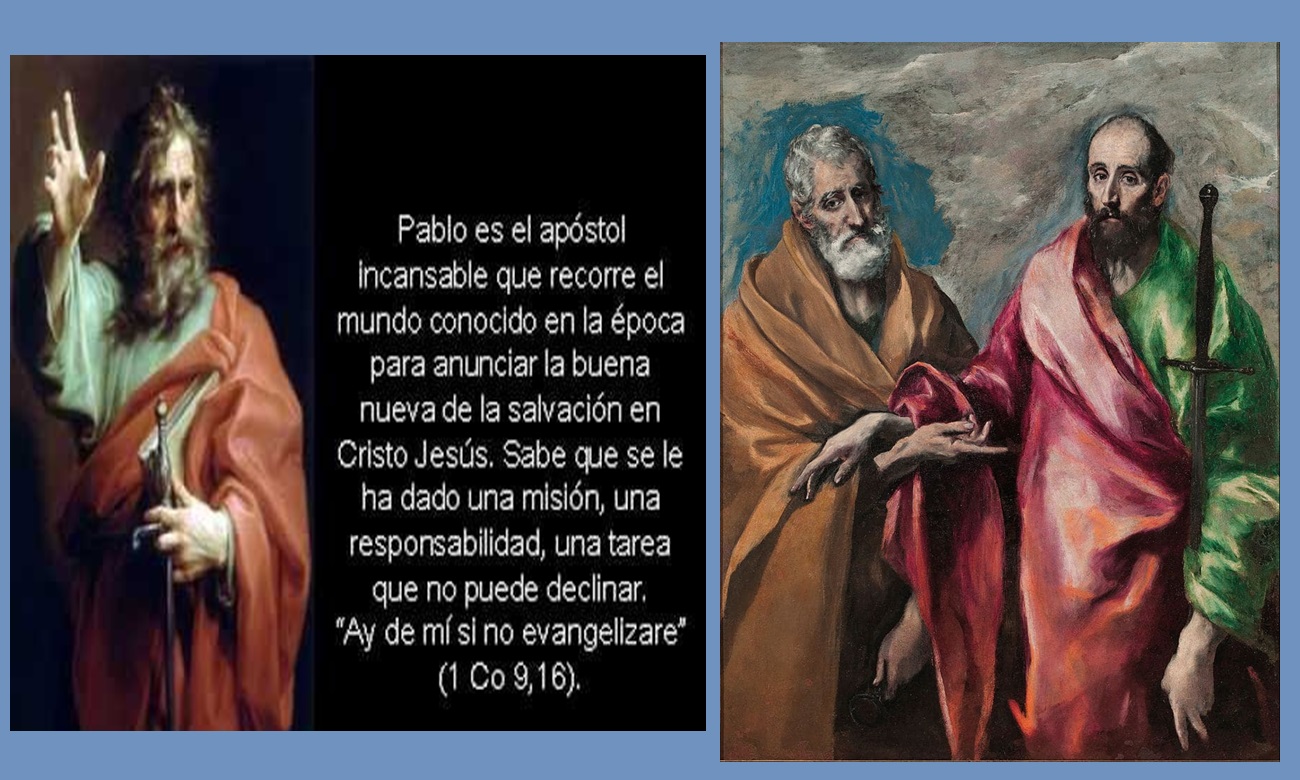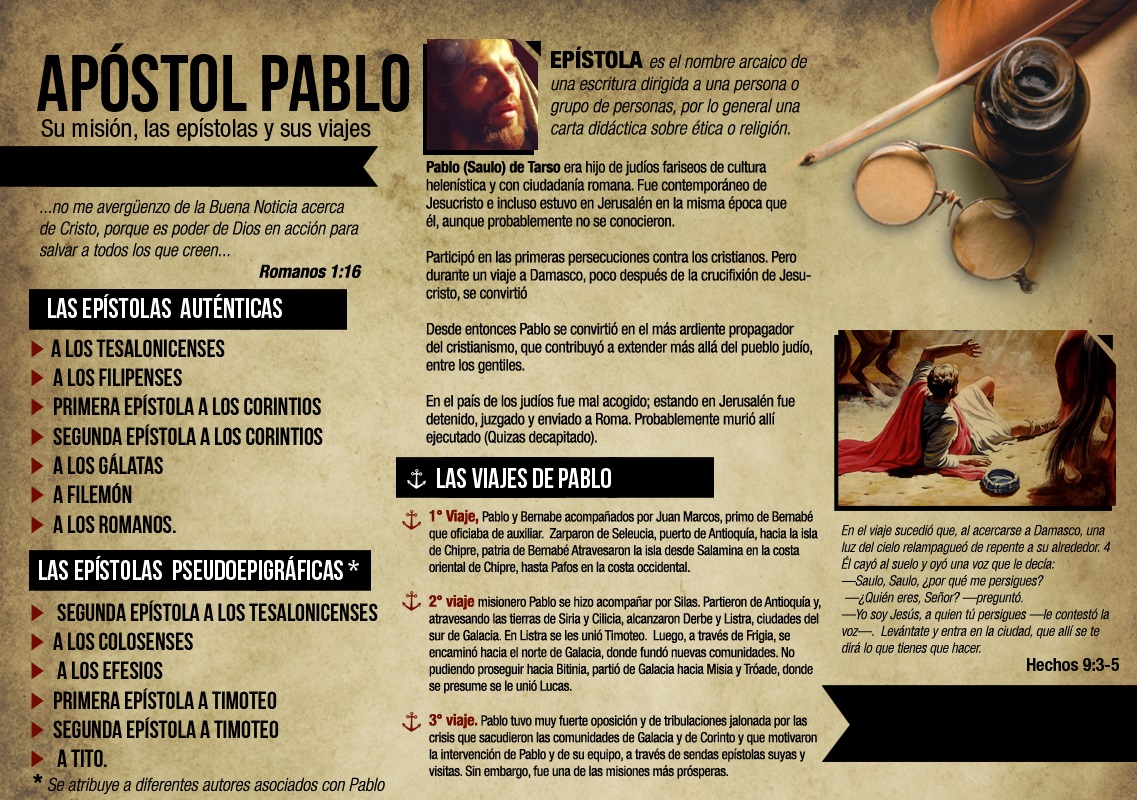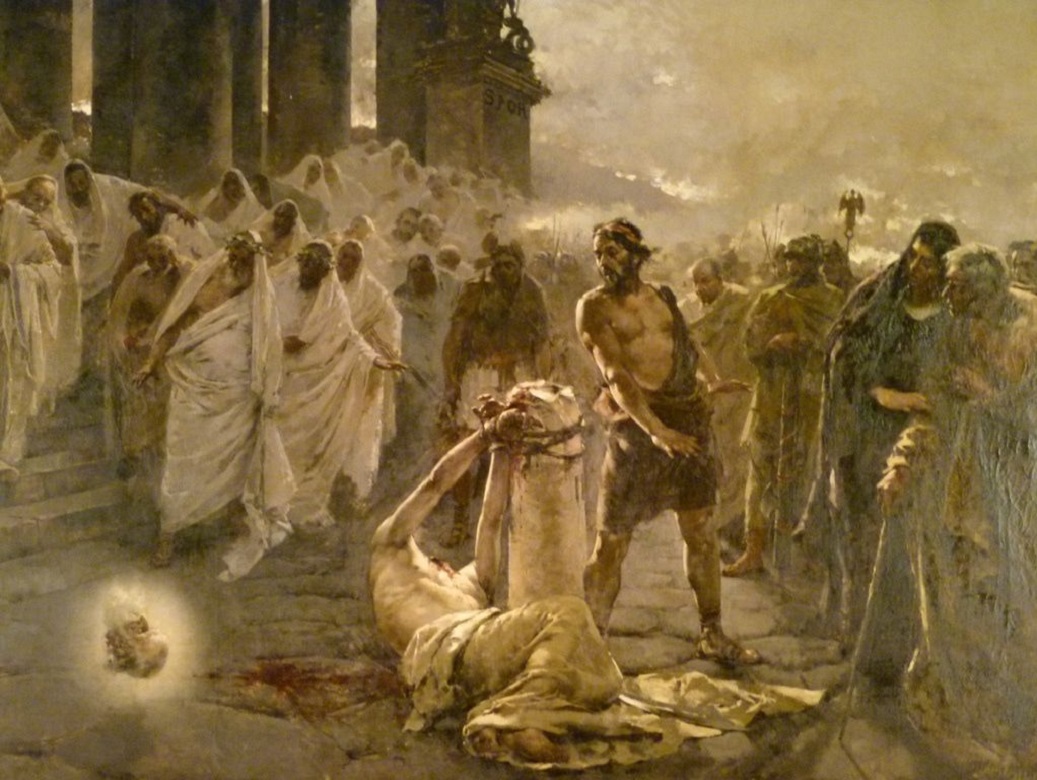Throughout this article you will discover the life and work of the biblical character known as: Saint Paul of Tarsus. A man who after being a persecutor of Christians, became the most fervent preacher of the gospel of the Lord Jesus.

Saint Paul of Tarsus
Saint Paul of Tarsus or Saul of Tarsus was a man belonging to the Jewish sect known as the Pharisees. The followers of this Judaic doctrine of the Pharisees were staunch persecutors of Jesus of Nazareth in his time of inhabiting the earth.
Saul of Tarsus was trained in the Pharisaic doctrine and in the days of his youth he became involved in the first Jewish persecutions of Christians.
If you found this post interesting, we invite you to learn more about this topic here Christian persecutions: story of terror and pain.
Where you can find out how the Christian Persecutions were, not only those suffered by the primitive church in the times of the Roman Empire. But you will also know those that suffered in modern times, and those that the Christian people still suffer today.
The persecutory work of Saul of Tarsus against the Christians came to an end once the risen Jesus appeared to him, when he was on his way to Damascus. After this face-to-face meeting of Saul with Jesus, from there his conversion to Christianity takes place, adopting the name given by the Lord of Saint Paul of Tarsus.
Born again after the experience lived in the presence of Jesus, the new man Paul of Tarsus became the most fervent promoter and promulgator of the Christian faith. A faith that he was in charge of spreading not only in Jerusalem but in territories beyond it, through missionary trips.
With these missionary trips Paul of Tarsus achieved the conversion of a large number of gentile people to Christianity. This man was also the author of fundamental teachings of Christian doctrine.
Teachings that were captured for posterity in 14 apostolic letters contained in the New Testament of the Bible.
Biography of Saint Paul of Tarsus
Saint Paul of Tarsus his birth name was Saul of Hebrew origin and as the epithet given to his name says, he was born in Tarsus, the main city of the Roman province of Cilicia, currently Turkey. Saul's birth is believed to have been between AD 5 and 10.
The information of this possible period of birth is extracted by some historians from the letter that Paul writes to Philemon while he was imprisoned in Ephesus:
Philemon 9 (NIV) I prefer to beg you in the name of love. I, Paul, old man and now also prisoner of Christ Jesus,
The writing date of this letter is estimated to be in the mid-50s AD in Ephesus, or early 60s in Caesarea or Rome.
For those times a person was considered old when reaching 50 or 60 years of age, from here it follows that Saint Paul of Tarsus was born in the early years of the first century, so that he was contemporary with the Lord Jesus.
The evangelist Lucas in the book of acts, also confirms the provenance or origin of Paul. Information that has credence to be considered true:
Acts 9:11 (NIV): -Go, go to the house of Judas, on the street called Straight, and ask for a certain Saul of Tarsus. He is praying.
It also corroborates that Greek was Paul's mother tongue, product of the information provided by the map of Palestine when Jesus, about the Jewish diaspora to Hellenistic and Roman lands.
Learn more here about the map of Palestine at the time of Jesus, where you will learn their political organization, existing theological doctrines, social groups, etc.
Tarsus gave Roman citizenship by birth, so Paul was a Roman citizen despite being the son of Jews.
Family, culture and education
Saint Paul of Tarsus originally Saul was born into a Jewish family of prosperous artisans, whose father belonged to the sect or select group of the Pharisees. So Paul had a Hebraic and Pharisaical culture by generational descent, but by his place of birth his identity as a citizen was Roman.
Once he finished his primary studies in Tarsus, on the Jewish culture, Saul was sent by his father to Jerusalem to advance in higher studies with the best scholars of the Jewish Law. Once in Jerusalem, Saul became a disciple of Rabbi Gamaliel, who was the grandson of Hillel, the forerunner of one of the two main schools of Pharisaic doctrine, the house of Beit Hillel.
In this way, Saul obtains a consolidated academic training, specifically in regard to theology, philosophy, legalism, and economics. In addition to being instructed in other languages besides the mother Greek, such as Latin, Hebrew and ancient Aramaic.
Saul of Tarsus persecutor of Christians
Although Saul by the date of his birth is considered to be contemporary with Jesus; historians believe that he was not living in Jerusalem at the time of the Lord's crucifixion, approximately in the 30th year of the first century. However, in accordance with the extremely rigid formation on the Pharisaic doctrine that Saul had received, it made him a persecuting leader of the first Christians who emerged after the crucifixion of Christ Jesus.
For those times the nascent Christian community was considered by the Jews as a heretical sect, with a discordant doctrine to the Jewish teaching. With the orthodox inflexibility that Saul possessed he had him present at the execution of the first Christian martyr known as Stephen.
Execution that took place in Jerusalem in the year 36 after Christ, according to the book of Acts of the apostles, reveals the presence and action of Saul in the death of the martyr Stephen:
Acts 7:58 (NIV): They pushed him out of the city and began to stone him. accusers they ordered their cloaks to a young man named Saul.
Acts 8:1 (NIV): And Saul was there, approving of Stephen's death.
Acts 8:2-3 (NIV): Some godly men they buried Stephen and they made great mourning for him. 3 Saul, on the other hand, wreaked havoc in the church: entering from house to house, dragged men and women and put them in jail.
The conversion of Saul of Tarsus
The conversion of Saul of Tarsus to Christianity is narrated in chapter 9 of the book of acts to the apostles. This process begins when Saul goes and appears before the high priest, so that he can grant him official letters of extradition addressed to the synagogues of Damascus.
Saul's objective was to seek, arrest and take to Jerusalem to be tried, all those who claimed to follow the doctrine of the Way, as the early Christian church was known, regardless of whether they were men or women. The council of the Sanhedrin of Israel approved the mission requested by Saul, and he goes to Damascus.
However, on the road to Damascus, Saul experiences the wonderful revelation of divine power by witnessing the risen Jesus. Presence that manifests itself in the form of a mysterious light, of such intensity that it blinds him and makes him prostrate himself to the ground; according to the book of Acts and several of Paul's writings in his letters, it was the resurrected Jesus Christ who appeared to him.
The Lord Jesus rebuked Paul for his behavior saying, Saul, why do you persecute me? Saul also receives the call to become a servant of the Lord as an apostle of the Gentiles, the non-Jewish people, to preach his message of salvation among them.
After this divine experience, already converted to Saint Paul of Tarsus, he gets in touch with the Christian communities of the region. He then spends some time in a cloister in the wilderness, where he deepens and affirms the foundation of his newly adopted faith.
Paul back in Damascus is now seriously persecuted by his former fellow Jewish fanatics. This makes him have to clandestinely leave the city in the year 39 after Christ.
Saint Paul of Tarsus the Apostle to the Gentiles
After leaving the city of Damascus in hiding, Paul goes to Jerusalem and contacts Peter and the rest of the apostles of Jesus. At first this relationship was not very easy because of his previous conduct of persecuting the Christians in the Holy City.
One of the deacons named Bernabé, because he knew him or perhaps because he was a relative, served as guarantor for Pablo de Tarso before the Christian community of Jerusalem; later the apostle returns to his hometown and dedicates himself to preaching the message of Jesus until the year 43 after Christ, when Barnabas comes to him. Barnabas's intention to look for Paul in Tarsus was because they had been appointed to go to Antioch at that time from Syria.
Antioch was a modern and prosperous city where a large number of followers of Jesus' message were emerging, who were Gentiles or non-Jews. It was in this city that the followers of Christ Jesus were given the qualification of Christians for the first time.
The mission of Paul and Barnabas was to assist and help the community of Christians in Antioch with the support of those in Jerusalem. The sermons of Saint Paul of Tarsus that he did successively attending the different Jewish synagogues; It was not well received and almost always ended in complete failure.
At first there were very few Hebrews who managed to embrace the Christian faith from the preaching of Saint Paul of Tarsus. While his teachings were much more effective among the gentile people, as well as the indifferent people who knew nothing of the Judaic religion.
mission trips
Saint Paul of Tarsus, together with Barnabas, set out to start three missionary journeys through Asia Minor and other regions of the territory of Palestine from Antioch. These missionary trips toured cities that are described below:
First trip
This journey took Paul and Barnabas to Cyprus in the year 46 after Christ, and later to several cities in Asia Minor. The new pseudonym adopted by the apostle, which was his second name of Latin origin Paul or Paulus, because it had the Roman connotation of him, allowed him to better develop his mission among the gentile people.
Paul's mission allowed the message of Jesus to come out of the Jewish, Palestinian environment, thus becoming a universal message. On this first trip Christian communities or churches were also created in Perge, Antioch in Pisidia, Lystra, Iconium and Derbe in Lycaonia.
One of the successes of this evangelizing work of the apostle Paul was to allow the imposition of the opinion that the Gentile Christians had to have the same deference as the Jews. Because Paul argued that the redemption through the grace of Christ represented the final sunset of the Mosaic Law and exempted the Gentiles from the obligation to comply with various Judaic practices.
Second trip
Made between 50 and 53 after Christ, the Christian churches of Anatolia were visited, they toured part of Galatia, as well as some cities of proconsular Asia. Later they went to Macedonia and Achaia, the evangelization was done specifically in cities such as Filippo, Thessalonica, Berea and Corinth.
Similarly, Athens was visited by Saint Paul of Tarsus on this trip, where he issued the famous Areopagus speech there, combating Stoic philosophy. While Paul was in Corinth, he possibly began his work as a writer, writing the first and second Epistle to the Thessalonians.
Third travel
Trip made between the years 53 and 58 after Christ, visiting the communities in Asia Minor. Later he continued through Macedonia and Achaia, the city of Ephesus being chosen as the center of this journey and in which Paul stayed for about three years.
Paul from Ephesus wrote the first letter to the Corinthians, in which the difficulties encountered by the Christian faith within a libertine and frivolous environment such as that of that city is clearly manifested; Some historians attribute the city of Ephesus as the place where Paul wrote the epistle to the Galatians and the one addressed to the Philippians. On this trip and shortly after being in Macedonia, the apostle writes the second letter to the Corinthians.
Later, while in Corinth, the apostle sends the relevant doctrinal epistle to the Romans. In this letter, Paul emphasizes and touches in depth the theme of the relationship between faith and works with respect to salvation, preparing the Christian communities for an upcoming visit to Rome.
Last years
When Paul goes to Jerusalem to deliver a generous collection for the humble Christian community of that city, he is taken as a prisoner. In Jerusalem the apostle spends two years in Roman military custody.
Later they decide to send him heavily guarded on a ship bound for Rome, with the aim that the courts of Emperor Nero would decide judgment on Paul. The sea voyage was marked by important episodes such as the shipwreck and the miraculous salvation.
This miraculous salvation of the ship's crew gave the apostle prestige in the eyes of his custodians. Between the years 61 and 63, Saint Paul of Tarsus lived in Rome, one time in prison and another in prison at home with probation and private custody. In this Roman captivity, Paul wrote the letter to the Ephesians, to the Colossians, and to Philemon.
The courts set the apostle free for not considering the accusations against him to be solid. Paul restarts his ministry and evangelizes in Crete, Illyria and Achaia; some affirm that he could also be in Spain.
From this date date the first letter to Timothy and the one addressed to Titus, in these letters a deep organizing activity of the Church is observed, by the apostle Paul.
Death of Saint Paul of Tarsus
Pablo was imprisoned again in the year 66, when he was denounced by a false brother of the Christian faith. Imprisoned in Rome he writes the most moving of his letters, the second Epistle to Timothy.
Where the apostle expresses to Timothy his only desire to suffer for Christ and give his life for the Church. Imprisoned, the apostle felt humanly abandoned by all, then sentenced to death; as it corresponded to a Roman citizen, decapitated with the sword, probably in the year 67 after Christ.
Thought of Saint Paul of Tarsus
The thought of Saint Paul of Tarsus was established in his letters, where he established the doctrinal and theological foundation of Christianity. But the really meritorious work of him was having been an interpreter and precursor of the message of the Lord Jesus.
Saint Paul of Tarsus is credited with the opportune and clear separation between Christianity and Judaism. In his evangelizing work, Paul spread his theological thought of Christianity, whose focal point was the universality of redemption and the new covenant under grace established by Christ, which superseded the old Mosaic law.
Continue with us reading Where was Jesus of Nazareth born?: Life, miracles and much more, to get to know in depth the life of the son of God.






